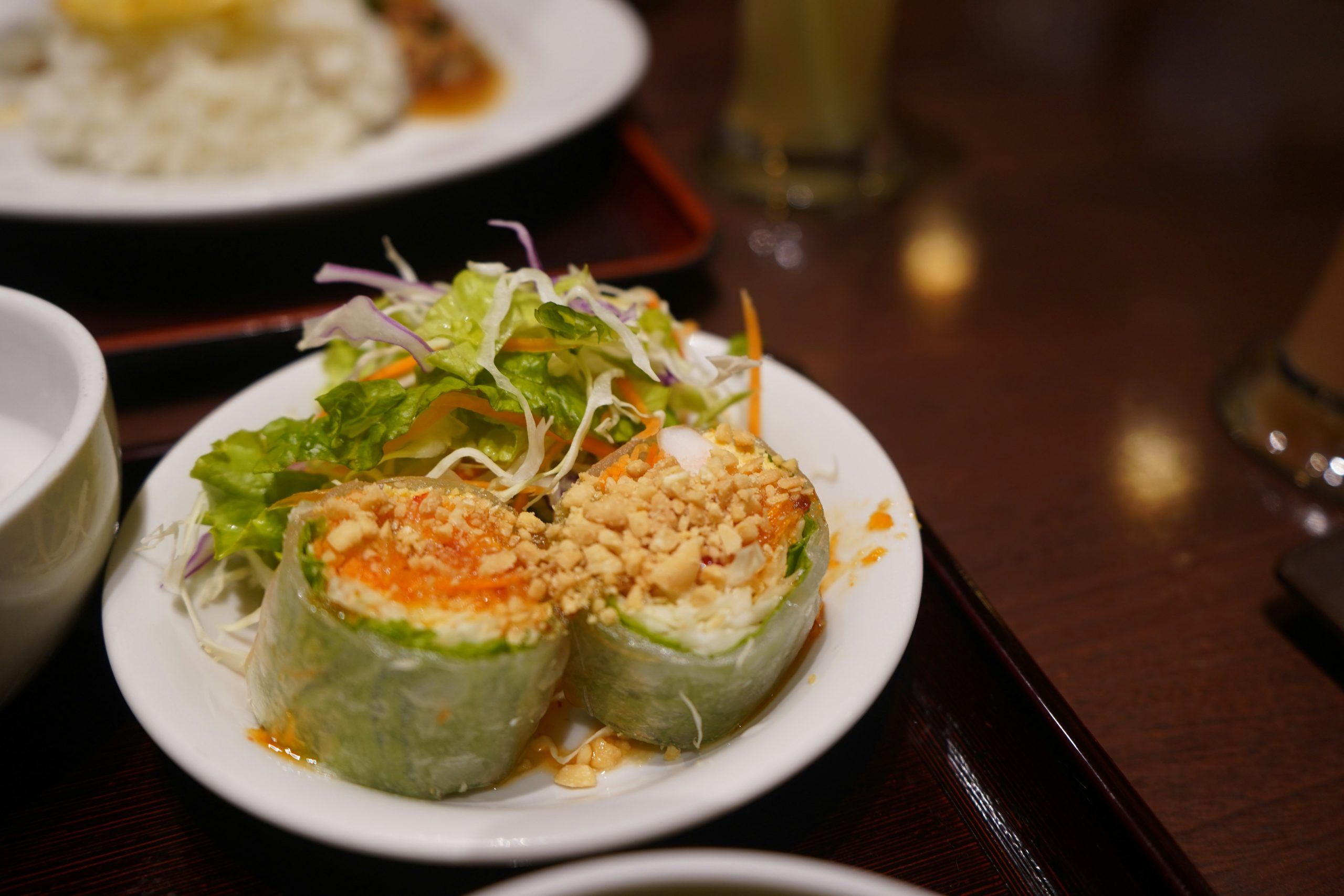A Journey Through Authentic Foods to Try in Thailand
Thailand offers more than just sandy beaches and golden temples. At its core lies a rich and vibrant food culture that reflects centuries of trade, tradition, and tropical abundance. The local culinary scene invites travelers to discover authentic foods to try in Thailand, each dish telling a story of place and people.
Across the country, dishes vary in flavor, technique, and ingredients. From bold Isaan spices to creamy Southern curries, regional variety adds complexity to what many consider typical Thai foods. Moreover, these meals aren’t just nourishment, they are experiences. Sitting at a bustling market table, watching vendors toss sizzling ingredients into woks, and tasting freshly chopped herbs all shape an unforgettable food journey.
Sampling famous Thai cuisine provides insight into culture, geography, and tradition. Dishes like Tom Yum Goong and Khao Soi offer both satisfaction and connection to local life. By understanding what locals eat and how meals are prepared, travelers gain a deeper appreciation of Thai identity.
In the following sections, explore 12 essential dishes, crafted to guide a journey through flavor and culture. Whether sweet, sour, spicy, or savory, each one earns its place among the most iconic foods in Thailand.
1. Som Tum: A Bold Beginning Among the Foods to Try in Thailand
Spicy Green Papaya Salad that Defines Typical Thai Foods
Som Tum, also known as green papaya salad, stands as one of the most famous Thai cuisines. Originating in the northeastern Isaan region, this dish offers a bold combination of heat, sourness, and natural sweetness. Made fresh to order, it blends shredded unripe papaya with chili, lime, fish sauce, and palm sugar. The crunch of papaya contrasts beautifully with the tangy dressing.
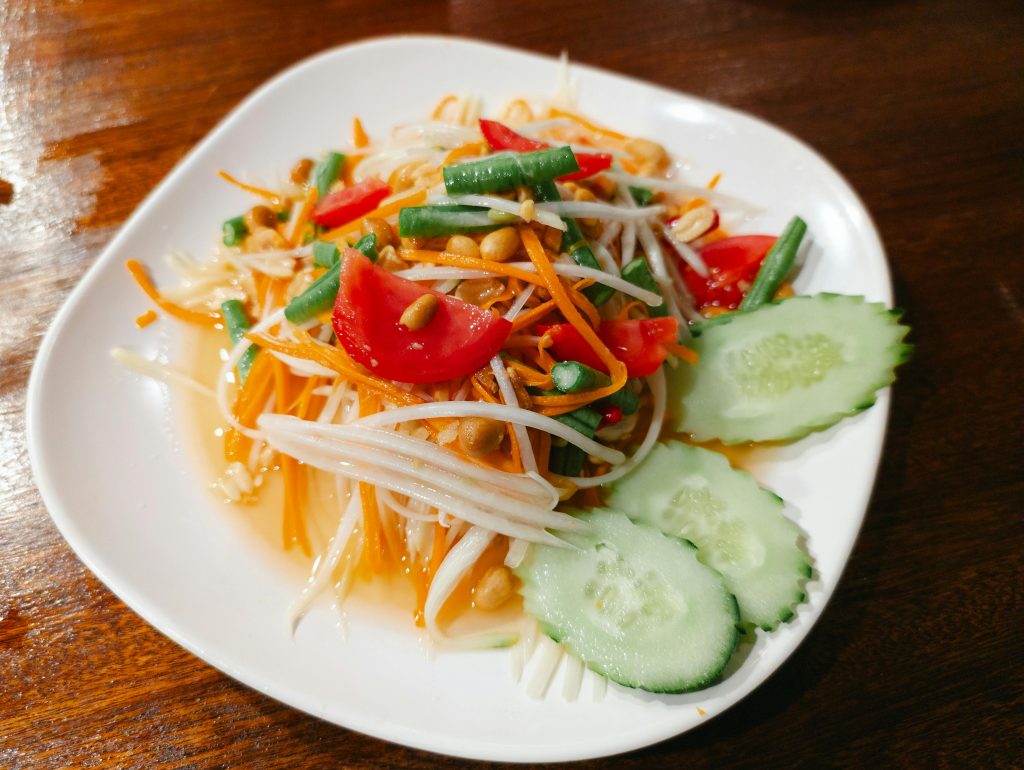
Traditionally pounded in a wooden mortar, this spicy salad embraces complex flavor layers. Local versions may include salted egg, fermented crab, or dried shrimp, depending on the region. Each variation adds depth, enhancing the already vibrant profile.
Som Tum often accompanies sticky rice and grilled meats. It’s a staple in street markets, where vendors pound ingredients together with precision and rhythm. The result delivers intense satisfaction with every bite.
Variations of Som Tum
| Type | Key Ingredients | Region |
| Som Tum Thai | Peanuts, lime, fish sauce, dried shrimp | Central Thailand |
| Som Tum Poo | Fermented crab, no peanuts | Northeast (Isaan) |
| Som Tum Kai Kem | Salted egg, slightly richer flavor | Bangkok, Urban |
In any form, Som Tum belongs high on the list of foods to try in Thailand, offering an energetic introduction to Thai culinary style.
2. Tom Yum Goong: Iconic Shrimp Soup from Famous Thai Cuisine
A Fragrant, Fiery Must-Try Among Foods in Thailand
Tom Yum Goong ranks among the most popular Thai dishes, known globally for its bold and refreshing taste. This hot and sour soup features shrimp, lemongrass, kaffir lime leaves, galangal, and Thai chilies. The blend creates a sharp, citrusy aroma that hits the senses even before the first sip.
What makes Tom Yum special is the balance. The broth is light but layered with intense flavor. While the shrimp provides protein, mushrooms and herbs add body and depth. In some regions, coconut milk is added for a creamier variation, making the soup richer without sacrificing spice.
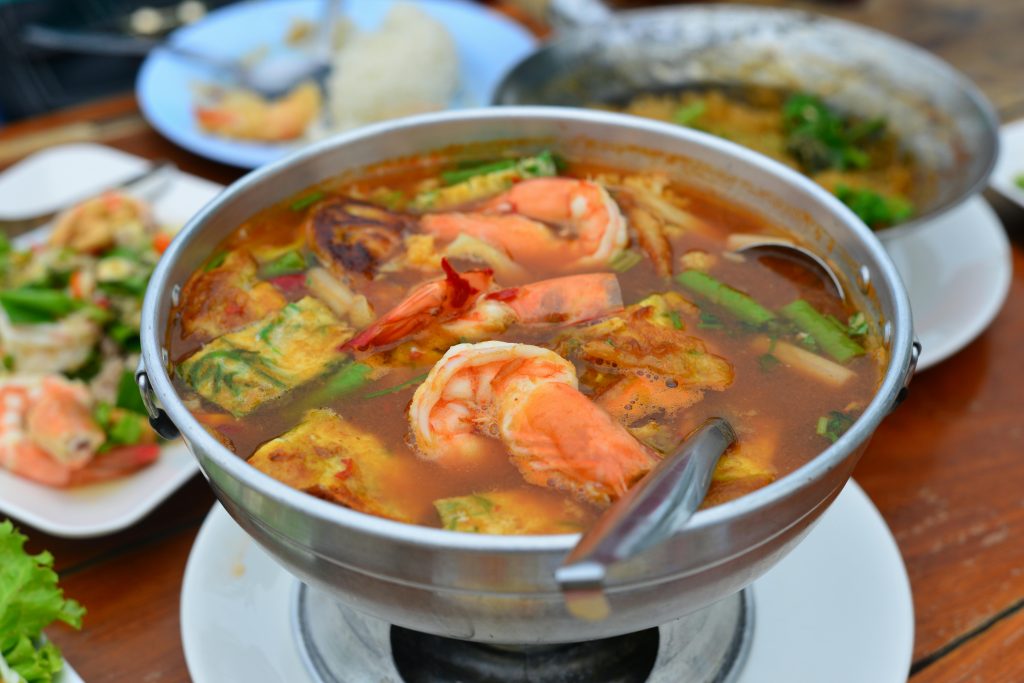
The soup is commonly found in both street stalls and high-end restaurants. Whether served in a clay pot or a metal hotpot, it reflects Thailand’s vibrant food culture.
Key Flavor Elements in Tom Yum Goong
- Sour: Fresh lime juice and lemongrass
- Spicy: Crushed Thai bird’s eye chilies
- Savory: Fish sauce and shrimp broth
- Aromatic: Kaffir lime leaves and galangal
Because of its complexity and balance, Tom Yum Goong remains an essential choice among authentic foods to try in Thailand. It captures the heart of famous Thai cuisine in a single bowl.
3. Khao Soi: Creamy Curry Noodles from Northern Thai Cuisine
A Comforting Classic Among Popular Thai Dishes
Khao Soi offers a unique take on curry, distinguishing itself among typical Thai foods. This dish hails from Northern Thailand, particularly Chiang Mai, where it’s a beloved comfort food. Combining soft egg noodles in a coconut-based curry broth with a topping of crispy fried noodles, Khao Soi offers both richness and crunch in every bite.
The broth features curry paste, coconut milk, and tender chicken or beef. Unlike spicier southern curries, Khao Soi delivers a mild but deeply satisfying flavor. Lime, pickled mustard greens, and raw red onions are served on the side, allowing diners to adjust the taste to personal preference.
Often eaten during lunch, Khao Soi is found in street stalls, local markets, and traditional family kitchens. While it remains lesser known internationally, within Thailand it is celebrated for its regional authenticity and complexity.
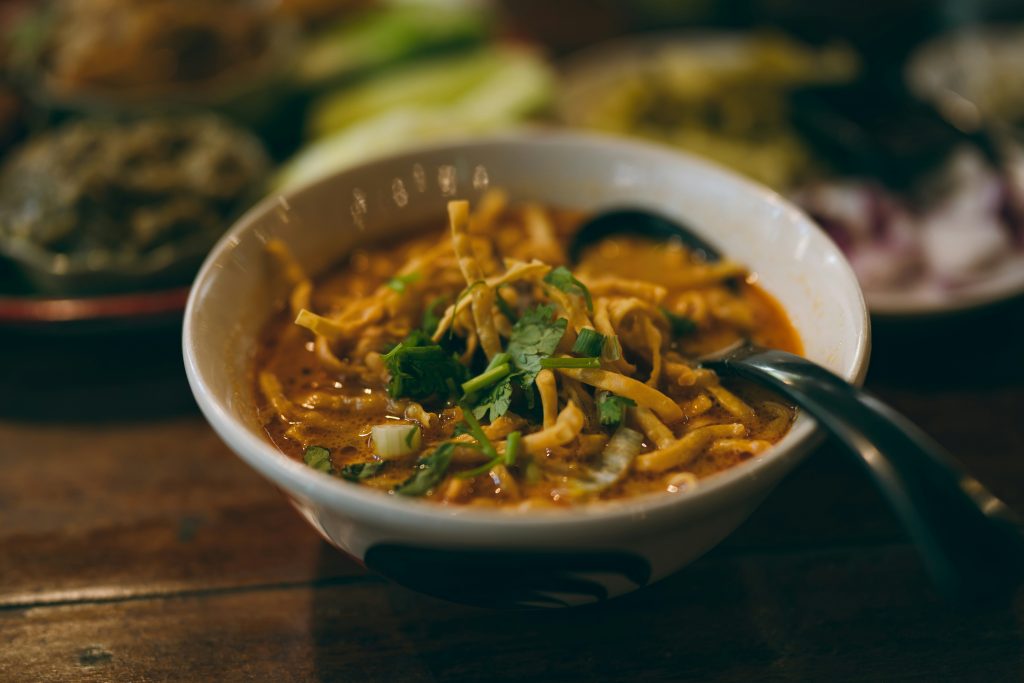
Why Khao Soi Stands Out
- Texture contrast between boiled and fried noodles
- Layered flavors with mild heat and savory curry
- Customizable toppings for added freshness and acidity
- Cultural depth linking Burmese and Lanna culinary traditions
Among the foods to try in Thailand, Khao Soi is a standout. It delivers warmth, history, and unmistakable flavor in every bowl.
4. Pla Pao: Salt-Crusted Grilled Fish in Foods to Try in Thailand
An Earthy Favorite Among Typical Thai Foods
Pla Pao is a whole freshwater fish grilled over hot coals with a thick crust of coarse salt. Wrapped in pandan or lemongrass leaves before grilling, the fish absorbs herbal fragrance while the salt protects the meat, keeping it moist and tender inside. This preparation creates a smoky, flavorful dish with a crispy skin that peels away easily.
As one of the more rustic foods in Thailand, Pla Pao is commonly served at floating markets, lakeside stalls, or rural family gatherings. The fish, often tilapia or snakehead, pairs with spicy dipping sauces like Nam Jim Seafood, featuring chili, lime juice, garlic, and sugar.
How Pla Pao is Prepared
| Step | Process Description |
| Cleaning | Fish is gutted but left whole |
| Stuffing | Lemongrass and kaffir lime packed inside |
| Coating | Entire fish covered in a thick salt layer |
| Grilling | Slowly cooked over charcoal for 30–45 minutes |
This dish exemplifies the simplicity and depth of famous Thai cuisine. While ingredients are basic, the outcome is bold, smoky, and authentic. Served with sticky rice and fresh greens, Pla Pao earns its place on every list of foods to try in Thailand.
5. Moo Ping: Grilled Pork Skewers Among Popular Thai Dishes
A Sweet-Savory Street Food Classic in Famous Thai Cuisine
Moo Ping, or grilled pork skewers, stands as one of the most popular Thai dishes found in street markets across the country. The dish is made by marinating thin slices of pork in a mixture of garlic, coriander root, soy sauce, sugar, and coconut milk. Once grilled over open charcoal flames, the meat becomes caramelized, tender, and full of flavor.
Sold by street vendors from early morning to late night, Moo Ping is often served with sticky rice. It’s quick to prepare, easy to eat on the go, and packed with balanced flavors that reflect the essence of typical Thai foods.
Key Elements of a Perfect Moo Ping
- Marinade Time: At least 4–6 hours for deep flavor
- Grill Technique: Cooked low and slow over charcoal
- Serving Suggestion: Pair with spicy dipping sauce and sticky rice
- Flavor Profile: Sweet, salty, smoky, and slightly spicy
Moo Ping’s simplicity makes it widely loved, but its flavor complexity keeps it memorable. As part of authentic foods to try in Thailand, it showcases Thailand’s mastery of grilled meats and street food culture.
6. Khanom Jeen Nam Ngiao: A Northern Gem Among Typical Thai Foods
Tangy Rice Noodle Soup from Northern Thailand’s Food Traditions
Khanom Jeen Nam Ngiao is a bold, tomato-based noodle soup from Northern Thailand. This lesser-known dish holds a deep cultural connection to the Lanna region. Made with soft khanom jeen (fermented rice noodles) and a tangy broth featuring pork, tomatoes, and dried red chilies, this dish stands out for its vibrant color and punchy flavor.
The broth gains richness from pork bones, fermented soybeans, and sometimes cubes of pork blood. Toppings often include crispy pork rinds, lime wedges, pickled vegetables, and raw bean sprouts. Despite its complexity, it remains a staple among locals and a standout in the landscape of typical Thai foods.
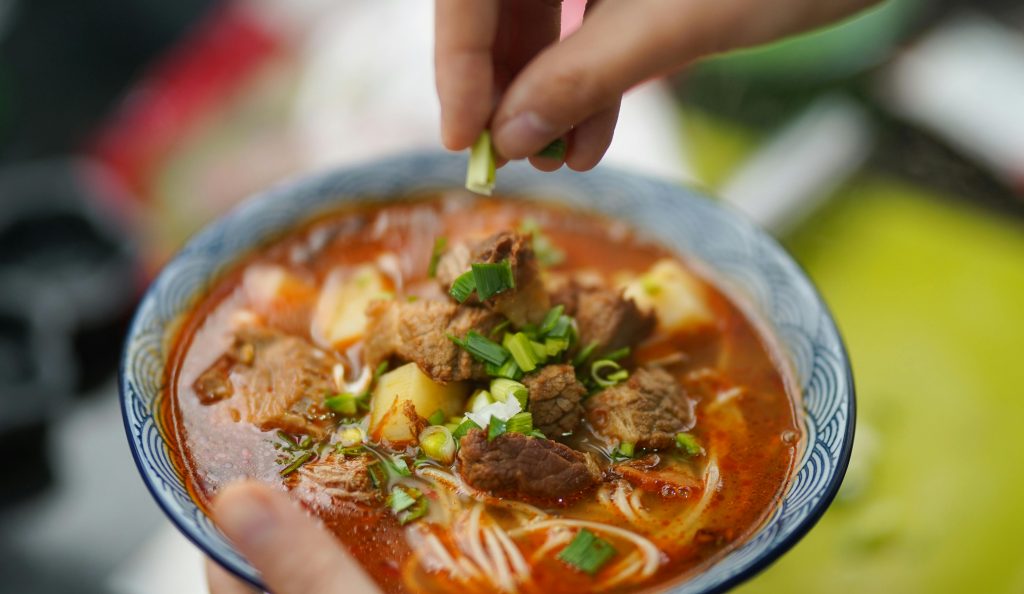
Why Khanom Jeen Nam Ngiao Deserves Attention
| Component | Flavor Role |
| Fermented noodles | Soft, slightly sour base |
| Tomato-based broth | Tangy and savory |
| Fried garlic topping | Adds aroma and crisp texture |
| Lime and chili flakes | Customizable heat and acidity |
While it may not appear on every tourist menu, this dish is cherished by those who seek authentic foods to try in Thailand. Its strong flavors, regional roots, and comforting texture make it a true culinary experience.
7. Hoy Tod: Crispy Oyster Omelet in Famous Thai Cuisine
A Savory Seafood Delight Among Popular Thai Dishes
Hoy Tod, or Thai oyster omelet, is a crisp and chewy seafood favorite found in bustling street food stalls and open-air markets. This dish combines a rice flour batter with eggs, fresh oysters (or mussels), and bean sprouts, all fried until golden brown on a flat iron pan. The result is a crunchy exterior with a soft, flavorful center.
Frequently served with a side of chili sauce and garnished with cilantro or spring onions, Hoy Tod offers a combination of textures rarely found in similar dishes. Its popularity across regions makes it one of the more intriguing foods to try in Thailand, especially for seafood lovers.
Ingredients That Make Hoy Tod Unique
- Oysters or Mussels: Provide briny richness
- Rice Flour Batter: Ensures crisp texture
- Eggs: Bind the ingredients while adding softness
- Bean Sprouts: Add freshness and balance
This dish thrives in high-heat cooking conditions, often prepared right in front of customers. Watching the sizzling process becomes part of the experience. As a staple of famous Thai cuisine, Hoy Tod showcases the country’s culinary creativity through humble ingredients and expert technique.
8. Gaeng Hang Lay: Northern Pork Curry from Typical Thai Foods
A Mild, Aromatic Dish Rooted in Thailand’s Regional Cuisine
Gaeng Hang Lay, also known as Burmese-style pork curry, is a rich and mildly spiced dish from Northern Thailand. It differs from other Thai curries in both texture and taste. Made with fatty cuts of pork belly, this curry simmers slowly in a blend of garlic, ginger, turmeric, tamarind, and roasted spices. Unlike coconut-based curries, Gaeng Hang Lay uses no cream, relying instead on slow cooking to develop a deep, earthy flavor.
This dish traces its roots to Burmese culinary influences, making it one of the more distinctive foods to try in Thailand. Served with sticky rice or steamed jasmine rice, it provides comfort and warmth, especially in the cooler regions of Chiang Mai and Chiang Rai.
Why Gaeng Hang Lay Stands Out
| Element | Culinary Impact |
| Pork belly | Tender texture and savory richness |
| Tamarind | Adds gentle sourness |
| Garlic & ginger | Provide warmth and aroma |
| Long simmer time | Creates soft texture and depth |
As part of famous Thai cuisine, Gaeng Hang Lay proves that not all Thai food is fiery. Instead, it showcases balance, complexity, and cultural fusion, hallmarks of typical Thai foods in the North.
9. Kai Jeow: Thai-Style Omelet in Foods to Try in Thailand
A Simple Yet Flavorful Staple in Typical Thai Foods
Kai Jeow, or Thai-style omelet, is a quick and satisfying dish found across the country. Though it may appear simple, this golden, crispy-edged egg dish delivers powerful flavor. Typically made with beaten eggs, fish sauce, and a splash of lime juice, it is often served over steamed jasmine rice and paired with a spicy chili sauce.
Street vendors commonly add minced pork, crab meat, or herbs to enrich the texture. Fried in hot oil, Kai Jeow develops a crispy outer layer while remaining fluffy inside. It’s often one of the first meals Thai children learn to cook, and yet, it holds a permanent place among the most popular Thai dishes for adults as well.
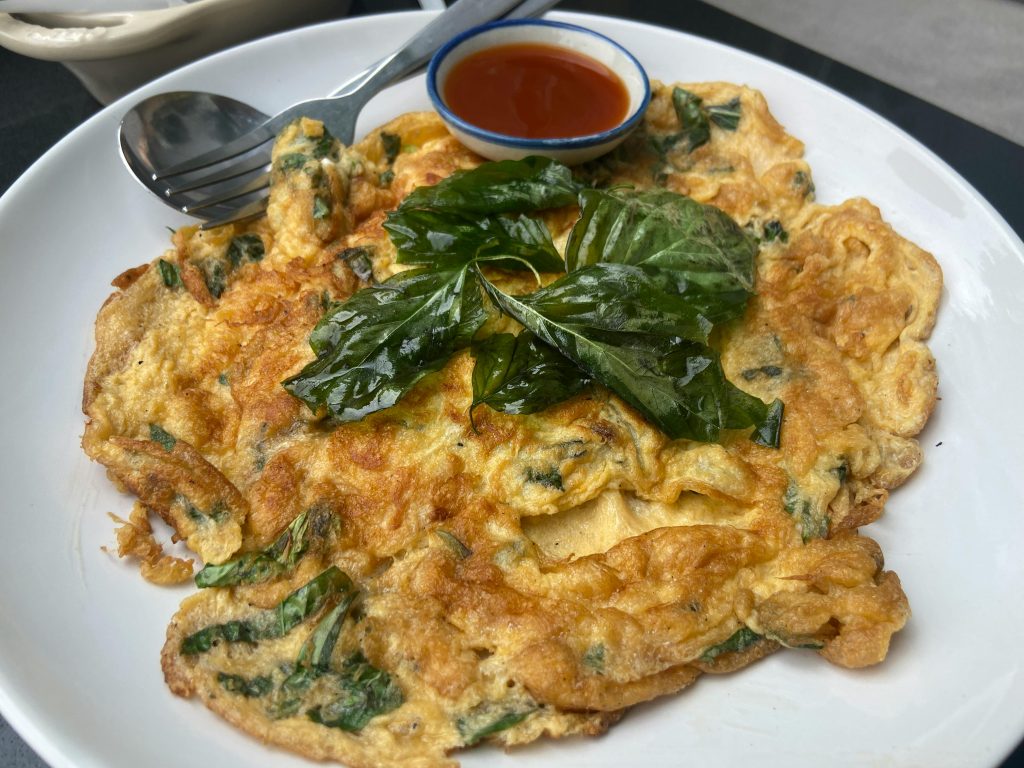
What Makes Kai Jeow a Thai Favorite
- Quick to Prepare: Cooked in under 5 minutes
- Versatile Toppings: Pork, shrimp, or even tofu
- Perfect Pairing: Best enjoyed with rice and hot sauce
- Affordable and Accessible: Found everywhere from homes to street corners
As one of the most common yet beloved foods in Thailand, Kai Jeow reminds diners that flavor doesn’t always come from complexity. Sometimes, the most memorable meals are the simplest.
10. Pad See Ew: Stir-Fried Noodles from Popular Thai Dishes
A Savory, Smoky Classic Among Famous Thai Cuisine
Pad See Ew is a hearty noodle dish that ranks high among popular Thai dishes. Wide rice noodles are stir-fried with dark soy sauce, Chinese broccoli, and a protein such as chicken, pork, or tofu. The dish is cooked quickly over high heat, which gives it a distinct smoky flavor known locally as “wok hei.”
Unlike some spicier Thai dishes, Pad See Ew is mild and deeply savory. The soy-based sauce gives the noodles a slightly sweet, umami-rich glaze. Thai street vendors prepare it in large batches, serving it fresh and hot in just minutes.
Key Features of Pad See Ew
| Ingredient | Role in Flavor and Texture |
| Wide rice noodles | Provide chewy, satisfying bite |
| Dark soy sauce | Adds color and deep savory taste |
| Chinese broccoli | Offers a slight bitterness and crunch |
| Protein (optional) | Customizes the dish with added richness |
As one of the most filling and accessible foods to try in Thailand, Pad See Ew appears everywhere, from school canteens to night markets. Its popularity comes from balance: chewy noodles, crisp greens, and a bold yet approachable flavor profile.
11. Miang Kham: Leaf-Wrapped Snacks in Typical Thai Foods
A Bite-Sized Flavor Explosion in Famous Thai Cuisine
Miang Kham is a traditional Thai snack that combines multiple flavors into one satisfying bite. Served as a DIY dish, diners use wild betel leaves (cha plu) to wrap a mix of toasted coconut, lime cubes (peel included), dried shrimp, peanuts, shallots, ginger, and chili. A sweet-savory sauce made from palm sugar, fish sauce, and tamarind paste ties everything together.
Unlike heavier meals, Miang Kham is light but bold. Every bite delivers a complex mix sweet, salty, spicy, sour, and bitter. It’s a favorite during festive gatherings and temple events, often offered as an appetizer or communal snack.
Ingredients Commonly Found in Miang Kham
| Component | Flavor Function |
| Betel leaves | Earthy, peppery wrap |
| Toasted coconut | Adds sweetness and crunch |
| Dried shrimp | Provides saltiness and umami |
| Tamarind-palm syrup | Binds everything with tangy sweetness |
Among the lesser-known foods to try in Thailand, Miang Kham represents traditional eating culture. It encourages sharing, slows down the dining experience, and creates conversation. While small in size, each wrap delivers a huge impression.
12. Khao Niew Mamuang: Mango Sticky Rice in Famous Thai Cuisine
A Sweet Tropical Favorite Among Foods to Try in Thailand
Khao Niew Mamuang, or mango sticky rice, is one of the most beloved Thai desserts. It combines sticky glutinous rice cooked with coconut milk and sugar, paired with ripe mango slices. A drizzle of salted coconut cream and a sprinkle of toasted mung beans or sesame seeds complete the dish. The contrast of textures and flavors creates a balanced, satisfying finish.
Though simple, this dessert stands as an icon in famous Thai cuisine. It is most commonly enjoyed during mango season (April to June), when the fruit is at peak ripeness. Street vendors, cafes, and fine-dining establishments all serve this dish, each with slight variations in presentation.
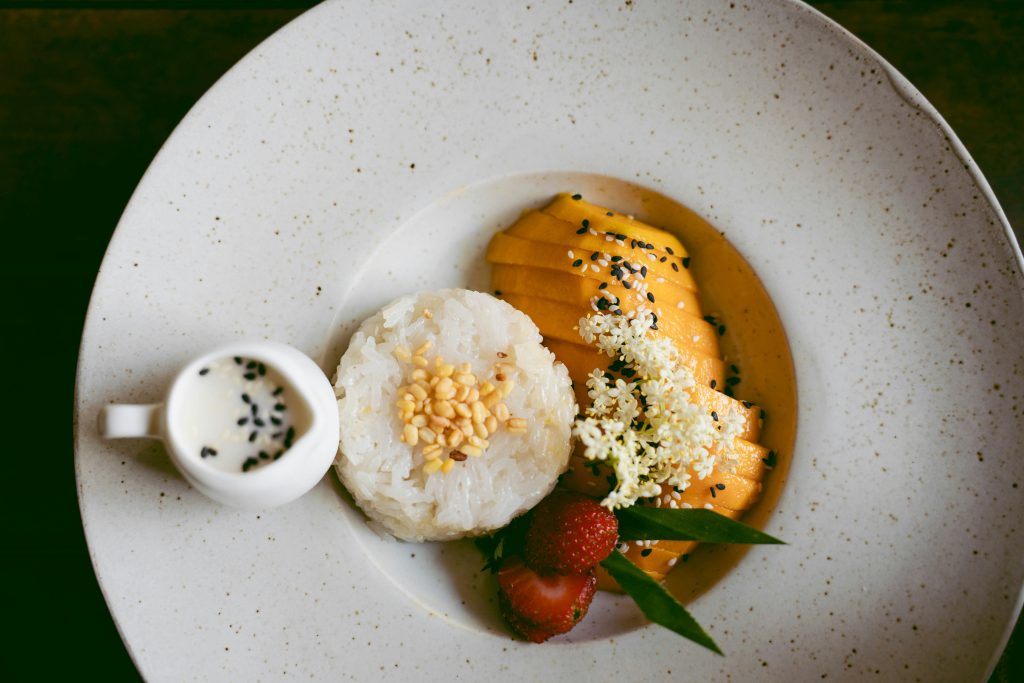
What Makes Mango Sticky Rice Special
- Ripe Mango: Adds freshness and natural sweetness
- Sticky Rice: Absorbs sweet coconut milk for richness
- Coconut Cream: Provides a creamy, slightly salty balance
- Toasted Toppings: Add crunch and visual appeal
Khao Niew Mamuang is more than a dessert, it’s a seasonal celebration and a sensory treat. As one of the sweetest foods to try in Thailand, it delivers a memorable ending to any Thai meal.
Bringing It All Together: A Culinary Journey Through Foods in Thailand
Exploring the many foods to try in Thailand reveals much more than recipes or ingredients. Each dish reflects geography, tradition, and identity. From the fiery salads of the northeast to the creamy curries of the north, Thai cuisine is a blend of regional techniques, seasonal produce, and deep cultural values.
A full appreciation of famous Thai cuisine involves understanding the balance it achieves, sweet against sour, heat with richness, crunch beside softness. Meals are rarely eaten alone. Instead, they are shared, discussed, and enjoyed communally. This spirit is present in street markets, family kitchens, and countryside stalls.
Regional Influences on Typical Thai Foods
| Region | Signature Dishes | Flavor Profile |
| Northeast (Isaan) | Som Tum, Laab, Sticky Rice | Spicy, tangy, bold |
| North | Khao Soi, Gaeng Hang Lay | Mild, aromatic, slow-cooked |
| Central | Tom Yum Goong, Pad Thai | Balanced, vibrant, accessible |
| South | Gaeng Som, Turmeric Fried Fish | Spicy, herbal, seafood-forward |
Understanding Thailand’s food is a gateway to understanding the country itself. Every meal tells a story, and every flavor carries memory. The experience of eating local, authentic dishes creates lasting impressions far beyond the final bite.
Local Tips for Enjoying Authentic Foods in Thailand
Sampling authentic foods to try in Thailand becomes more enjoyable when approached with a bit of insider knowledge. While flavors play a major role, how and where food is eaten also shapes the experience. Locals pay attention to preparation, surroundings, and eating etiquette. Learning these habits enhances appreciation for every dish.
Practical Tips for Food Exploration
Here are proven tips to navigate Thailand’s vibrant culinary scene with confidence:
- Start with Local Markets
- Morning markets offer the freshest dishes. Arrive early for items like Khanom Jeen or grilled meats.
- Morning markets offer the freshest dishes. Arrive early for items like Khanom Jeen or grilled meats.
- Look for Busy Vendors
- High foot traffic usually means high quality. Crowded stalls often serve the most popular Thai dishes.
- High foot traffic usually means high quality. Crowded stalls often serve the most popular Thai dishes.
- Adjust Spice Levels
- Use key Thai phrases: “mai ped” (not spicy), “ped nid noi” (a little spicy), or “ped mak” (very spicy).
- Use key Thai phrases: “mai ped” (not spicy), “ped nid noi” (a little spicy), or “ped mak” (very spicy).
- Pair Meals with Sticky Rice
- Many dishes, especially from the north and northeast, pair best with sticky rice instead of regular jasmine rice.
- Many dishes, especially from the north and northeast, pair best with sticky rice instead of regular jasmine rice.
- Respect Eating Customs
- Use a spoon in the right hand and fork in the left. Chopsticks are usually reserved for noodles.
With these tips, exploring famous Thai cuisine becomes both rewarding and memorable. Every vendor and meal offers an opportunity to engage with local culture through food.
Why These Are the Essential Foods to Try in Thailand
Thailand’s culinary landscape is one of the most diverse and immersive in the world. Every dish introduces a new layer of flavor, and every region contributes something distinct. From fiery Som Tum to creamy Khao Soi, the variety of typical Thai foods speaks to the country’s richness in culture and tradition.
These foods to try in Thailand are more than just meals, they are connections to local life, passed through generations, prepared with intention, and served with hospitality. Whether enjoyed at a sidewalk vendor in Bangkok or a quiet eatery in Chiang Rai, these dishes reveal Thailand’s heart through its flavors.
For travelers looking to go beyond the plate, pair this culinary guide with the Thailand Itinerary 10 Days: Must-See Spots & Hidden Gems. Together, they create a complete, unforgettable journey through Thailand’s tastes, places, and people.
What Dish Captured Your Attention Most? Have you tried any of these dishes already? Planning to explore more on your next trip?
- Share your thoughts in the comments below!
- Help fellow travelers by sharing this guide, spread the flavors of Thailand!
- Engage with the content, leave a comment, and let’s keep the conversation (and the cravings) going.

